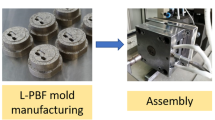Abstract
Micro molding is one of key technologies for mass production of polymer micro parts and structures with high aspect ratios. The authors developed a commercially available micro injection molding technology for high aspect ratio microstructures (HARMs) with LIGA-made mold inserts and pressurized CO2 gasses. The test inserts made of nickel with the smallest surface details of 5 μm with structural height of 15 μm were fabricated by using LIGA technology. High surface quality in terms of low surface roughness of the mold inserts allowed using for injection molding. Compared to standard inserts no draft, which is required to provide a proper demolding, was formed in the inserts. To meet higher economic efficiency and cost reduction, a fully electrical injection molding machine of higher accuracy has been applied with dissolving CO2 gasses into molten resin. The gasses acts as plasticizer and improves the flowability of the resin. Simultaneously, pressurizing the cavity with the gasses allows high replication to be obtained. Micro injection molding, using polycarbonate as polymer resins, with the aspect ratio of two was achieved in the area of 28 × 55 mm2 at the cycle time of 40 s with CO2 gasses, in contrast to the case of the aspect ratio of 0.1 without the gasses.











Similar content being viewed by others
References
Akamatsu M, Mayama T (2003) AMOTEC injection molding technology using CO2 and injection compression molding for fine pattern replication. Plast Age (Japanease) 49(2):101–103
Becher EW, Ehrfeld W, Hagmann P, Maner A, Muenchmeyer D (1986) Fabrication of microstructures with high aspect ratio and great structural heights by synchrotron radiation lithography, electroforming and plastic molding (LIGA process). Microelectron Eng 4:35–56
Datta P, Goettert J (2007) Method for polymer hot embossing process development. Microsyst Technol 13:265–270
Despa MS, Kelly KW, Collier JR (1999) Injection molding of polymeric LIGA HARMs. Microsyst Technol 6:60–66
Guckel H (1996) Deep X-ray lithography for micromechanics and precision engineering, Rev. Sci Instrum 67:3357
Haverkamp V, Ehrfeld W, Gebauer K, Hessel V, Löwe H, Richter T, Wille C (1999) The potantial of micromixers for contacting of disperse liquid phases. Fresenius J Anal Chem 364:617–624
Heckele M, Bacher W, Müller KD (1998) Hot embossing––the molding technique for plastic microstructures. Microsyst Technol 4:122–124
Hirose S, Miyatake T, Li X, Toyota E, Hirose M, Fujii K, Suzuki K (2000) Performance of a compact beamline with high brightness for X-ray lithography. J Vac Sci Technol B18:2986–2989
Hori T, Takayama T (1995) 4th international conference on synchrotron radiation sources and 2nd Asian forum on synchrotron radiation (proceedings). POSTECH, Pohang, pp 148–158
Michaeli W, Rogalla A (1996) Moulding in miniature. Eur Plast News, April: 45
Morton KJ, Strum JC, Austin RH, Chou SY (2006) Nanoimprinted fluidic device for continuous separation of nanoparticles. Proc of μ TAS 1:1014–1016
Piotter V, Benzler T, Hanemann T, Wöllmer H, Ruprecht R, Haußelt J (1999) Innovative molding technologies for the fabrication of components for microsystems. SPIE 3680:456–463
Piotter V, Mueller K, Plewa K, Ruprecht R, Hausselt J (2002) Performance and simulation of thermoplastic micro injection molding. Microsyst Technol 8:387–390
Ruprecht R, Bacher W, Hausselt J, Piotter V (1995) Injection molding of LIGA and LIGA-similar microstructures using filled and unfilled thermoplastics. SPIE 2639:146–157
Simoide K, Mawatari K, Mukaiyama S, Fukui H (2002) Bio-chemical analysis on microfabricated polymer chips. Proc of μTAS 2:918–921
Wallabe et al (2001) RibCon: Micromolded easy-assembly multi fiber connector for single- and multi-mode applications. Proc of DTIP conference. SPIE 4408:478–485
Yamaki H (2001) Novel injection molding technology using CO2. Plast Age (Japanese) 47(6):136–139
Yorita J, Numasawa T, Hirata Y (2004) Manufacturing technology of micromold inserts and micromolding. High Polym 53(5):322–325
Zhang Y, Katoh T (1996) Synchrotron radiation micromachining of polymers to produce high-aspect-ratio microparts. Jpn J Appl Phys 35:L186–L188
Acknowledgments
The authors thank all staffs of our SR facility for the operation of the source and Mr. H. Hayasaki and Mr. Y. Satou for stimulating discussions concerning polymer injection molding and polymer chemistry in the molding experiments.
Author information
Authors and Affiliations
Corresponding author
Rights and permissions
About this article
Cite this article
Katoh, T., Tokuno, R., Zhang, Y. et al. Micro injection molding for mass production using LIGA mold inserts. Microsyst Technol 14, 1507–1514 (2008). https://doi.org/10.1007/s00542-007-0533-8
Received:
Accepted:
Published:
Issue Date:
DOI: https://doi.org/10.1007/s00542-007-0533-8




